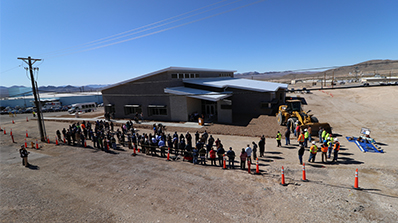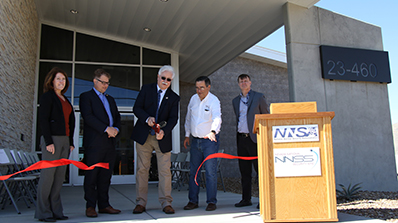The Nevada National Security Site (NNSS) marked a key milestone of Site modernization with the formal dedication of Mercury Building 1 on Feb. 24.
The 14,000-square-foot facility, delivered on schedule and under budget, represents the first of nine new modern facilities that will transform Mercury, an operational hub for the NNSS. Mercury Modernization will consolidate older, less efficient buildings, many of which date back to the 1960s, into a technologically enhanced walkable campus. Joined by National Nuclear Security Administration (NNSA), Nevada Field Office (NFO) and NNSS leadership, NNSA Principal Deputy Administrator Dr. William Bookless emphasized the role of Site modernization.
“Going forward, the aging infrastructure has to be replaced in order to be able to continue to support the nuclear deterrent,” said Dr. Bookless. “It is an element of our deterrent that is sometimes overlooked. I believe the deterrent isn’t just the warheads: it’s the infrastructure and it’s the people all combined to represent the nation’s nuclear deterrent.”
NNSS’ national security missions include supporting the stewardship of the nation’s nuclear deterrent, executing experiments in support of the National Laboratories, contributing to key nonproliferation and arms control initiatives, providing nuclear and radiological emergency response capabilities and training, and leading long-term environmental stewardship.
Building 1 features extensive utility upgrades and is built to Leadership in Energy and Environmental Design Gold standards as well as federal sustainability requirements. The building is credited as the NNSA’s second net-zero energy facility in the enterprise thanks to its alignment with the Mercury solar array, which debuted in 2018 and currently powers NNSS Fire Station 1, the first NNSA net-zero facility. The new Mercury campus will serve mission support functions while meeting the needs of the national security programs’ workforce.
“This building demonstrated innovative strategies that make facilities sustainable and more cost effective during the long term, in addition to providing examples of how to leverage the DOE enterprise capabilities in partnership with private and public sector resources,” said Mark Martinez, president of NNSS managing and operating contractor Mission Support and Test Services.

The success of the project is credited to collaborative efforts.
“Mercury Building 1 represents a steadfast partnership with an integrated planning team,” said Sheila Feddis of NNSA’s Office of Infrastructure, Operations and Modernization. “The comprehensive strategy and restructuring of Mercury supports workers’ needs, renews utilities and environment, and represents a landmark investment for the future.”
Mercury is serving as a prototype for the NNSA’s Standardized Acquisition and Recapitalization (STAR) initiative. Standardized designs are one strategy to accelerate modernization and enable the construction of new facilities in a more cost effective, timely manner relative to Site and mission needs.
As the NNSS moves forward with the next two facilities and other new construction throughout the complex, NNSA will mature and institutionalize the successes of the STAR. These efforts include shared, scalable standard designs that employ commercial practices to attract bidders and reduce costs, eliminating redundant oversight requirements that are appropriate only for nuclear and complex construction, and implementing centralized acquisition.
Building 1 houses emergency management and information technology capabilities for the Site. Future facilities will support operations, laboratories and training functions. Developed during the next decade, the campus will be crucial to attracting and retaining future employees through a contemporary environment and infrastructure.
“We expect this campus to be a critical part of the recruiting of the next generation of talent that will be coming out here: craft workers, engineers, scientists, technicians, accountants, emergency specialists, safety specialists and the broad spectrum of people—the kind of people we’re going to need to execute the nation’s missions,” said Martinez. “Mercury is going to be the hub for that, and this is the first building to kick that off. This building is a key part for the national security mission that we’re responsible for.”
Mercury building strategy will be leveraged for the area planning of other NNSS sites, including the U1a Complex, the Device Assembly Facility and Area 6.
“It really is a great time to be in Nevada with all the investments in the infrastructure and mission programs here,” said NNSA NFO Acting Manager Dr. David Bowman. “Everyone here who worked on this project or works on the mission projects—what you’re all doing is making the world a safer place.”

